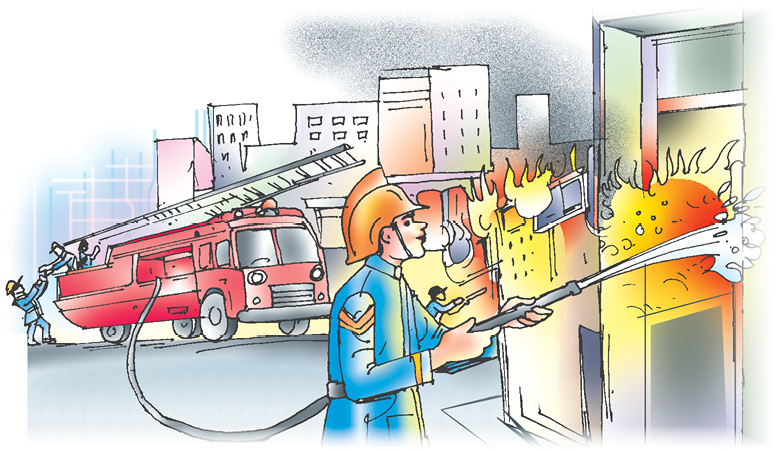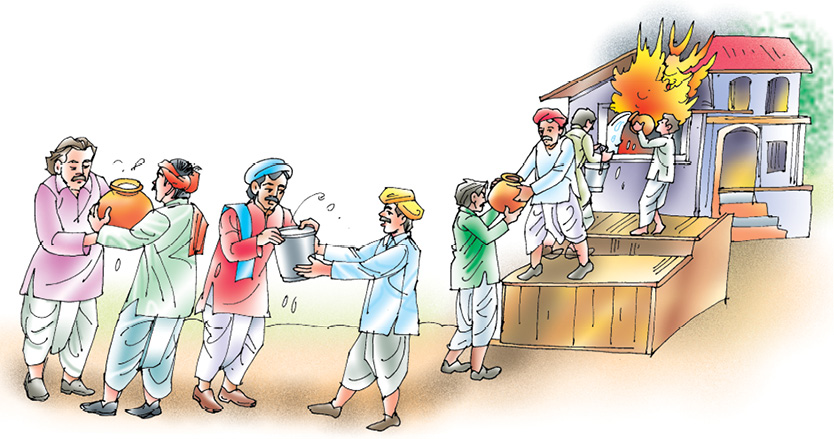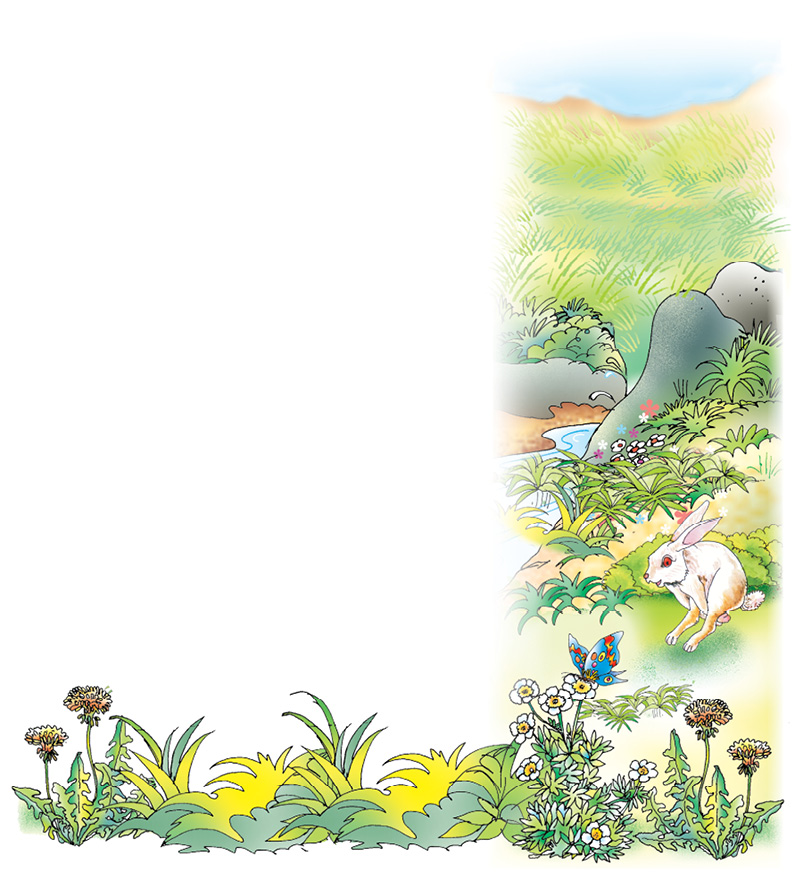Table of Contents
Notes for the Teacher
Units 8–10
Fire: Friend and Foe
- Natural phenomenon—fire is both friend and enemy. An informative piece about a potential hazard that can easily be prevented.
- The point that the simple present tense signifies habitual or repeated actions rather than the present time needs reiteration and further practice. Build on Activity I under ‘Working with Language’ and design two or three additional tasks. It will be interesting to show simple present in contrast with present continuous.
• I walk to school every morning. Today I am taking a bus.
• We have our morning assembly before the first hour, but today we are attending a special programme instead on health and hygiene. - The writing activity, as after ‘The Ashes that Made Trees Bloom’, is for further practice in language analysis.
- Read aloud the news item in the box at the end of the lesson. Ask children to find other news items/headlines on a specified theme. Display some on the class bulletin board.
Meadow Surprises
- Let children find pictures of a butterfly and other insects/birds, a buttercup and other flowers that they know, a rabbit and/or a running brook and arrange the pictures in a patchwork design of their choice.
- Activity 4 can be taken up as a mini project. Involve groups of children in doing it. The paragraph(s) or poem(s) written at the end of the week may be put up on the class bulletin board.
- Encourage children to share with their peers any interesting ‘surprise’ that they may have come across.
A Bicycle in Good Repair
- Humour — exaggerated details of a commonplace event (pleasure ride on a bicycle) that never takes off, though numerous unexpected things happen in the process.
- Short notes on modal auxiliaries are given preceding the three exercises under ‘Working with Language’. These may be suitably expanded, if necessary. However, the skill to use modals appropriately in contexts should receive primary focus in preference over out-of-context explanations.
- Activity 4 on ‘en’ as prefix, suffix or as part of the word should be completed in more than one session. One period may be devoted to each part including intermittent queries and explanations and the writing work involved.
Garden Snake
- Recite the poem with correct pauses.
- Draw children’s attention to the following.
1. That snake in the grass reported me to the Headmistress.
Does ‘snake’ refer to a snake in the meadow/grass or to a treacherous person who pretends to be a friend? ‘A snake in the grass’ is an idiom.
2. ‘Snake’ can be used as a verb.
• The road snakes its way through the mountains. (follows a twisting, winding course)
• The river snaked away into the distance. (moving like a snake, disappeared)
3. ‘snaky’ (like a snake)
• the snaky movements of the young dancers
• narrow snaky paths through the hill
The Story of Cricket
- Games and sport — the story of cricket told in a historical perspective, the continuity of the game down the ages and its emergence as the most popular modern sport and entertainment.
- Though the text is rather long and challenging, the content is exciting enough to work well in class. Most children know something about the game including names of players/teams, and will show enthusiasm for the story of cricket. Photographs given will enhance their interest in the lesson.
- No time need be expended on memorisation/recall of dates/years, names of places and clubs, measurements, etc. Additional sectioning of parts and designing of while-reading comprehension checks, as suggested elsewhere, will be of special use here.
- ‘Wordsearch’ clues to be explained at length before the activity is attempted. Another ‘Wordsearch’ for games-related words and phrases can easily be prepared in class.

8
Before you read
Fire is both useful and dangerous. What is fire? How did we discover it? How do we control it?
Fire: Friend and Foe
Early man didn’t know what fire was, but he must have seen the damage itcould cause. He must have watched lightning and volcanoes long before he began to use fire himself. Fire was powerful and dangerous, and he
was frightened.
Fire may have puzzled early man but we now know that fire is the result of a chemical reaction. When the oxygen in the air combines with carbon and hydrogen in a fuel, a chemical reaction takes place. Energy in the form of heat and light is released in this process. This is what we call fire.
smouldering: burning slowly without flame
Three things are needed to make fire— fuel, oxygen and heat. Wood, coal, cooking gas and petrol are some examples of fuel. Oxygen comes from the air. That is why, when you blow on smouldering paper, it often bursts into flame. The third thing needed to make fire is heat. Fuel and oxygen do not make fire by themselves, or else a newspaper or a stick lying in the open would catch fire on its own. To burn a piece of paper or wood, we heat it before it catches fire. We generally do it with a lighted match. Every fuel has a particular temperature at which it begins to burn. This temperature is called the ‘flash point’ or ‘kindling temperature’ of the fuel.

generate: produce
It is sometimes said that fire is a good servant but a bad master. It only means that fire is very useful as long as it is kept under control.
For instance, we use it to cook our food, warm our homes in winter and to generate electricity. But, on the other hand, if fire gets out of control it can be very dangerous. Each year thousands of homes and shops are damaged by fire. Vast areas of forest are also destroyed and hundreds of people are killed or injured.
Just as three things are needed to start a fire, there are three main ways in which a fire can be put out. In each, one of the three things needed for burning is taken away.
For example, we can take away the fuel. If the fire has no fuel to feed on, no burning can take place. We often let a fire die out simply by not adding more fuel to it.
add fuel to the flames (idiom): say or do something that makes people react more strongly and fiercely
smothered: suffocated (from lack of air)
extinguish: put out
The second way of putting out a fire is to prevent oxygen from reaching it. No supply of oxygen means no fire. Small fires can be put out or ‘smothered’ with a damp blanket or a sack. This stops oxygen reaching the burning material. Sometimes, carbon dioxide is used to extinguish fire. It does not allow oxygen to reach the
burning material.
The third way of putting out a fire is to remove the heat. If the temperature can be brought down below the flash point, the fuel stops burning. You blow on a burning matchstick or a candle to put it out. In doing so, you remove the hot air around the flame bringing down its temperature below the flash point, and the candle goes out. Sometimes, water is sprayed on a fire. It absorbs heat from the burning fuel and lowers the temperature. The blanket of water also cuts off the supply of oxygen, and the fire is extinguished.
Some fires cannot be put out with water. If water is sprayed onto an oil fire, the oil will float to the top of the water and continue to burn. This can be very dangerous because water can flow quickly, carrying the burning oil with it and spreading the fire. Water should also not be used on fires caused by electrical appliances. The person spraying water might receive an electric shock and be killed. A carbon dioxide extinguisher is the best thing to fight an electrical fire.
We spend millions of rupees each year in fighting fires. And we spend more trying to find new ways of preventing fires from happening and getting out of control. On the whole, we have learnt rather well to control fire and put it to good use in our everyday life.
Long ago, there were no firemen. When fire broke out, everybody became a firefighter. People formed human chains (they still do if required) and passed buckets of water from a well or a pond to the blaze. Now there are laws about building construction which ensure that space is left between buildings to reduce the fire risk. Every new building, especially a public place, must ensure observance of fire prevention norms. Bands of firefighting workers with special equipment, known as fire brigades, are there to put out fires. Firefighters are highly trained people. They possess many skills. They cut off electricity supply, knock down dangerous walls, spray water and other materials to bring fire under control.
bands: groups
equipment: things needed
cope: deal with; manage
They are also trained in first aid so that they can help people suffering from burns or from the effects of smoke.
The discovery of fire and its uses helped early man to cope with nature better and gradually adopt a settled mode of life. Fire is still worshipped in many parts of the world. Fire is indeed a friend but, as we know, it can be a dangerous enemy once it gets out of control.

Comprehension Check
1. Mark the correct answer in each of the following.
(i) Early man was frightened of
(a) lightning and volcanoes.
(b) the damage caused by them.
(c) fire.
(ii) (a) Fire is energy.
(b) Fire is heat and light.
(c) Fire is the result of a chemical reaction.
(i) That is fire.
(ii) A chemical reaction takes place.
(iii) Energy in the form of heat and light is released.
(iv) Oxygen combines with carbon and hydrogen.
(i) (ii) (iii) (iv) (ii) (iii) (i) (iv)
(iv) (iii) (ii) (i) (iv) (ii) (iii) (i)
Working with the Text
Answer the following questions.
1. What do you understand by the ‘flash point’ of a fuel?
2. (i) What are some common uses of fire?
(ii) In what sense is it a “bad master”?
3. Match items in Column A with those in Column B.
A B
(i) fuel – lighted matchstick
(ii) oxygen – air
(iii) heat – coal
– burning coal
– wood
– smouldering paper
– cooking gas
4. What are the three main ways in which a fire can be controlled or put out?
5. Match the items in Box A with those in Box B
A
(i) To burn paper or a piece of wood,
(ii) Small fires can be put out
(iii) When water is spread on fire,
(iv) A carbon dioxide extinguisher is the best thing
(v) Space left between buildings
B
• it absorbs heat from the burning material and
• lowers the temperature.
• reduces the risk of fire.
• with a damp blanket.
• we heat it before it catches fire.
• to put out an electrical fire.
6. Why does a burning candle go out when you blow on it?
7. Spraying water is not a good way of putting out an oil fire or an electrical fire. Why not?
8. What are some of the things you should do to prevent a fire at home and in the school?
Working with Language
1. Read the following sentences.
To burn paper or a piece of wood, we heat it before it catches fire. We generally do it with a lighted match. Every fuel has a particular temperature at which it burns.
The verbs in italics are in the simple present tense. When we use it, we are not thinking only about the present. We use it to say that something happens all the time or repeatedly, or that something is true in general.
Find ten examples of verbs in the simple present tense in the text ‘Fire: Friend and Foe’ and write them down here. Do not include any passive verbs.









2. Fill in the blanks in the sentences below with words from the box. You may use a word more than once.
carbon cause fire smother
(i) Gandhiji’s life was devoted to the  of justice and fair play.
of justice and fair play.
(ii) Have you insured your house against  ?
?
(iii) Diamond is nothing but  in its pure form.
in its pure form.
(iv) If you put too much coal on the fire at once you will  it.
it.
(v) Smoking is said to be the main  of heart disease.
of heart disease.
(vi) When asked by an ambitious writer whether he should put some  into his stories, Somerset Maugham murmured, “No, the other way round”.
into his stories, Somerset Maugham murmured, “No, the other way round”.
(vii) She is a  copy of her mother.
copy of her mother.
(viii) It is often difficult to  a yawn when you listen to a long speech on the value of time.
a yawn when you listen to a long speech on the value of time.
3. One word is italicised in each sentence. Find its opposite in the box and fill in the blanks.
spending shut destroy subtract increase
(i) You were required to keep all the doors open, not 
(ii) Pupil: What mark did I get in yesterday’s Maths test? Teacher: You got what you get when you add five and five and  ten from the total.
ten from the total.
(iii) Run four kilometres a day to preserve your health. Run a lot more to  it.
it.
(iv) If a doctor advises a lean and lanky patient to reduce his weight further, be sure he is doing it to  his income.
his income.
(v) The world is too much with us; late and soon,Getting and  we lay waste our powers.
we lay waste our powers.
– Wordsworth
4. Use the words given in the box to fill in the blanks in the sentences below.
across along past through
(i) The cat chased the mouse  the lawn.
the lawn.
(ii) We were not allowed to cross the frontier. So we drove  it as far as we could and came back happy.
it as far as we could and came back happy.
(iii) The horse went  the winning post and had to be stopped with difficulty.
the winning post and had to be stopped with difficulty.
(iv) It is not difficult to see  your plan. Anyone can see your motive.
your plan. Anyone can see your motive.
(v) Go  the yellow line, then turn left. You will reach the post office in five minutes.
the yellow line, then turn left. You will reach the post office in five minutes.
Speaking and Writing
1. Look at the following three units. First re-order the items in each unit to make a meaningful sentence. Next,
re-order the sentences to make a meaningful paragraph. Use correct punctuation marks in the paragraph.
(i) and eighteen fire tenders struggled/the fire began on Monday/to douse the blaze till morning
(ii) in a major fire/over 25 shops/were gutted
(iii) but property/was destroyed/worth several lakhs/no casualties were reported.
2. Read the following newspaper report given in the box below.
Fire Station Goes Up in Flames
A fire chief was embarrassed when a station without a smoke alarm went up in flames. The building and a fire engine were destroyed in the blaze. Nobody was injured in the fire that was tackled by 30 firefighters in six fire engines from neighbouring towns.
Meadow Surprises
Walk across a green field, a park or even under a clump of trees, and you will notice many wonderful things. What are some of the surprises a meadow has for someone with a keen eye and a sharp ear?

Meadows have surprises,
You can find them if you look;
Walk softly through the velvet grass,
And listen by the brook.
You may see a butterfly
Rest upon a buttercup
And unfold its drinking straws
To sip the nectar up.
You may scare a rabbit
Who is sitting very still;
Though at first you may not see him,
When he hops you will.
A dandelion whose fuzzy head
Was golden days ago
Has turned to airy parachutes
That flutter when you blow.
Explore the meadow houses,
The burrows in the ground,
A nest beneath tall grasses,
The ant’s amazing mound.
Oh! Meadows have surprises
And many things to tell;
You may discover these yourself,
If you look and listen well.
Lois Brandt Phillips
Working with the Poem
1. Read the lines in which the following phrases occur. Then discuss with your partner the meaning of each phrase in its context.
(i) velvet grass
(ii) drinking straws
(iii) meadow houses
(iv) amazing mound
(v) fuzzy head
2. Which line in the poem suggests that you need a keen eye and a sharp ear to enjoy a meadow? Read aloud the stanza that contains this line.
3. Find pictures of the kinds of birds, insects and scenes mentioned in the poem.
4. Watch a tree or a plant, or walk across a field or park at the same time everyday for a week. Keep a diary of what you see and hear. At the end of the week, write a short paragraph or a poem about your experiences. Put your writing up on the class bulletin board.
Read the following poem about the world of nature, which is as busy as the world of human beings.
Busy World
Frances Gorman Risser
Delivery Delayed
Answer
The postman started moving round the tree in circles. The dog followed him, but as he did so, his leash got wrapped around the tree. The postman then safely walked up to the front door.